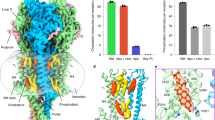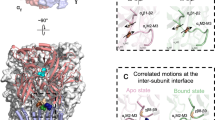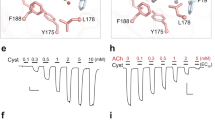Abstract
CONDUCTANCE measurements on various cholinergic post-junctional membranes have demonstrated voltage-dependent effects for acetylcholine (ACh) and its agonists1–5, for local anaesthetics6, and for curare5. It is not yet clear which of the steps in drug–receptor interaction are rate-limiting for voltage-dependent effects of ACh. Kordaš7 considers this step to be the initial binding between ACh and its receptor, whereas Magleby and Stevens8 consider the conformational changes between open and closed states of the receptor to be rate-limiting. Distinct from the initial binding reaction and the subsequent conformational change is the possibility of a drug binding to a receptor that is in its open, rather than closed, state, thereby forming a complex consisting of three molecular species. This idea comes from Steinbach's model9 for the action of local anaesthetics at the frog endplate. Such multi-molecular complexes have been included in reaction schemes which describe voltage-dependent effects for local anaesthetics at the frog endplate10 and for curare in Aplysia neurones5. Marty et al.5 found that during hyperpolarisation of molluscan neurones, curare became a more effective blocker of the response to slowly applied ACh. Such an effect of curare was not seen when ACh was applied quickly to the receptors, that is when there was insufficient time for ACh to equilibrate with its postsynaptic effect. They suggested that the binding between curare and the cholinergic receptor is voltage-dependent but that this particular kind of binding can only occur between curare and a receptor which is already in its open state. Here I show that curare has a very similar effect at the frog neuromuscular junction. The efficacy of curare as a postsynaptic blocker at the frog neuromuscular junction increases when the muscle fibre is hyperpolarised. This effect is seen only when ACh is applied slowly, however, and not when it is applied rapidly during neural release of ACh.
This is a preview of subscription content, access via your institution
Access options
Subscribe to this journal
Receive 51 print issues and online access
$199.00 per year
only $3.90 per issue
Buy this article
- Purchase on Springer Link
- Instant access to full article PDF
Prices may be subject to local taxes which are calculated during checkout
Similar content being viewed by others
References
Dionne, V. E. & Stevens, C. F. J. Physiol., Lond. 251, 245–270 (1975).
Adams, P. R. Pflügers Arch. 361, 145–151 (1976).
Neher, E. & Sakmann, B. Proc. natn. Acad. Sci. U.S.A. 72, 2140–2144 (1975).
Sheridan, R. E. & Lester, H. A. Proc. natn. Acad. Sci. U.S.A. 72, 3496–3500 (1975).
Marty, A., Neild, T. & Ascher, P. Nature 261, 502–503 (1976).
Beam, K. G. J. Physiol., Lond. 258, 279–300 (1976).
Kordaš, M. J. Physiol., Lond. 224, 333–348 (1972).
Magleby, K. L. & Stevens, C. F. J. Physiol., Lond. 223, 173–197 (1972).
Steinbach, A. B. J. gen. Physiol. 52, 162–180 (1968).
Ruff, R. L. Biophys. J. 16, 433–439 (1976).
Nastuk, W. L. Fedn Proc. 12, 102 (1953).
del Castillo, J. & Katz, B. J. Physiol., Lond. 128, 157–181 (1955).
Adrian, R. H. & Freygang, W. H. J. Physiol., Lond. 163, 61–103 (1962).
del Castillo, J. & Katz, B. Proc. R. Soc. B 146, 339–356 (1957).
Takeuchi, A. & Takeuchi, N. J. Physiol., Lond. 154, 52–67 (1960).
Jenkinson, D. H. J. Physiol., Lond. 152, 309–324 (1960).
Falk, G. & Fatt, P. Proc. R. Soc. B 160, 69–123 (1964).
Müller, K.-D., Dreyer, F. & Peper, K. Cold Spring Harb. quant. Biol. 40, 187–192 (1975).
Colquhoun, A. A. Rev. Pharmac. 15, 307–325 (1975).
Mallart, A., Dreyer, F. & Peper, K. Pflügers Arch. 362, 43–47 (1976).
Author information
Authors and Affiliations
Rights and permissions
About this article
Cite this article
MANALIS, R. Voltage-dependent effect of curare at the frog neuromuscular junction. Nature 267, 366–368 (1977). https://doi.org/10.1038/267366a0
Received:
Accepted:
Issue Date:
DOI: https://doi.org/10.1038/267366a0
This article is cited by
-
Excitatory effect of ATP on rat area postrema neurons
Purinergic Signalling (2006)
-
Mechanisms of tubocurarine action on nicotinic cholinoreceptors of rat sympathetic ganglia neurons
Neurophysiology (1988)
-
Curare can open and block ionic channels associated with cholinergic receptors
Nature (1982)
-
Blockade of acetylcholine-induced inward currents inAplysia neurons by strychnine and desipramine: Effect of membrane potential
Cellular and Molecular Neurobiology (1982)
Comments
By submitting a comment you agree to abide by our Terms and Community Guidelines. If you find something abusive or that does not comply with our terms or guidelines please flag it as inappropriate.



